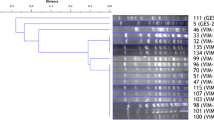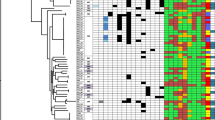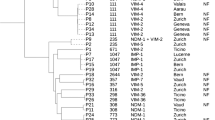Abstract
The aim of this study was to describe the molecular epidemiology and the mechanisms of resistance to β-lactams of emerging extensive-drug-resistant Pseudomonas aeruginosa (XDRPA) in a tertiary-care university hospital over a three-year period. Analysis included antimicrobial susceptibility profiling and pulsed-field gel electrophoresis (PFGE). Resistance mechanisms to β-lactams were identified: production of naturally occurring and acquired β-lactamases, overproduction of MexAB-OprM and MexXY efflux systems and loss of porin OprD were assessed. Eighteen patients were colonised or infected with XDRPA which remained susceptible to colistin and, to a lesser extent, to rifampicin. β-lactam resistance was, in most cases, due to the overproduction of AmpC, overproduction of the MexXY efflux system and loss of porin OprD. One isolate produced the class D extended-spectrum oxacillinase (OXA-ESBL) Oxa-28, but none produced metallo-β-lactamase (MBL) or class A extended-spectrum β-lactamase (ESBL). The XDRPA clustered in eight PFGE patterns and both the acquisition and loss of resistance determinants was observed within a single clone during its spread. The emergence of XDRPA isolates in our university hospital has been characterised by genotypic heterogeneity, variation of mechanisms of resistance to β-lactams in a single clone and the predominance of chromosomally encoded resistance mechanisms

Similar content being viewed by others
References
Ibrahim EH, Ward S, Sherman G, Kollef MH (2000) A comparative analysis of patients with early-onset vs late-onset nosocomial pneumonia in the ICU setting. Chest 117:1434–1442. doi:10.1378/chest.117.5.1434
Carmeli Y, Troillet N, Karchmer AW, Samore MH (1999) Health and economic outcomes of antibiotic resistance in Pseudomonas aeruginosa. Arch Intern Med 159:1127–1132. doi:10.1001/archinte.159.10.1127
Livermore DM (2002) Multiple mechanisms of antimicrobial resistance in Pseudomonas aeruginosa: our worst nightmare? Clin Infect Dis 34:634–640. doi:10.1086/338782
Masuda N, Sakagawa E, Ohya S, Gotoh N, Tsujimoto H, Nishino T (2000) Substrate specificities of MexAB-OprM, MexCD-OprJ, and MexXY-oprM efflux pumps in Pseudomonas aeruginosa. Antimicrob Agents Chemother 44:3322–3327. doi:10.1128/AAC.44.12.3322-3327.2000
Hsueh PR, Tseng SP, Teng LJ, Ho SW (2005) Pan-drug-resistant Pseudomonas aeruginosa causing nosocomial infection at a university hospital in Taiwan. Clin Microbiol Infect 11:670–673. doi:10.1111/j.1469-0691.2005.01196.x
Kallel H, Hergafi L, Bahloul M, Hakim A, Dammak H, Chelly H et al (2007) Safety and efficacy of colistin compared with imipenem in the treatment of ventilator-associated pneumonia: a matched case–control study. Intensive Care Med 33:1162–1167. doi:10.1007/s00134-007-0675-2
Deplano A, Denis O, Poirel L, Hocquet D, Nonhoff C, Byl B et al (2005) Molecular characterization of an epidemic clone of panantibiotic-resistant Pseudomonas aeruginosa. J Clin Microbiol 43:1198–1204. doi:10.1128/JCM.43.3.1198-1204.2005
Falagas ME, Koletsi PK, Bliziotis IA (2006) The diversity of definitions of multidrug-resistant (MDR) and pandrug-resistant (PDR) Acinetobacter baumannii and Pseudomonas aeruginosa. J Med Microbiol 55:1619–1629. doi:10.1099/jmm.0.46747-0
Balows A, Hausler WJ Jr, Herrmann KL, Isenberg HD, Shadomy HJ (1991) Manual of clinical microbiology, 5th edn. ASM Press, Washington, D.C.
Antibiogram Committee of the French Society for Microbiology Guidelines (2008) Available online at: http://www.sfm.asso.fr
Vogne C, Aires JR, Bailly C, Hocquet D, Plésiat P (2004) Role of the multidrug efflux system MexXY in the emergence of moderate resistance to aminoglycosides among Pseudomonas aeruginosa isolates from patients with cystic fibrosis. Antimicrob Agents Chemother 48:1676–1680. doi:10.1128/AAC.48.5.1676-1680.2004
Hocquet D, Berthelot P, Roussel-Delvallez M, Favre R, Jeannot K, Bajolet O et al (2007) Pseudomonas aeruginosa may accumulate drug resistance mechanisms without losing its ability to cause bloodstream infections. Antimicrob Agents Chemother 51:3531–3536. doi:10.1128/AAC.00503-07
Hocquet D, Bertrand X, Köhler T, Talon D, Plésiat P (2003) Genetic and phenotypic variations of a resistant Pseudomonas aeruginosa epidemic clone. Antimicrob Agents Chemother 47:1887–1894. doi:10.1128/AAC.47.6.1887-1894.2003
Dumas J-L, van Delden C, Perron K, Köhler T (2006) Analysis of antibiotic resistance gene expression in Pseudomonas aeruginosa by quantitative real-time-PCR. FEMS Microbiol Lett 254:217–225
Hocquet D, Nordmann P, El Garch F, Cabanne L, Plésiat P (2006) Involvement of the MexXY-OprM efflux system in emergence of cefepime resistance in clinical strains of Pseudomonas aeruginosa. Antimicrob Agents Chemother 50:1347–1351. doi:10.1128/AAC.50.4.1347-1351.2006
Bertrand X, Bailly P, Blasco G, Balvay P, Boillot A, Talon D (2000) Large outbreak in a surgical intensive care unit of colonization or infection with Pseudomonas aeruginosa that overexpressed an active efflux pump. Clin Infect Dis 31:E9–E14. doi:10.1086/318117
Tenover FC, Arbeit RD, Goering RV, Mickelsen PA, Murray BE, Persing DH et al (1995) Interpreting chromosomal DNA restriction patterns produced by pulsed-field gel electrophoresis: criteria for bacterial strain typing. J Clin Microbiol 33:2233–2239
Corvec S, Poirel L, Espaze E, Giraudeau C, Drugeon H, Nordmann P (2008) Long-term evolution of a nosocomial outbreak of Pseudomonas aeruginosa producing VIM-2 metallo-enzyme. J Hosp Infect 68:73–82. doi:10.1016/j.jhin.2007.10.016
Aubron C, Poirel L, Fortineau N, Nicolas P, Collet L, Nordmann P (2005) Nosocomial spread of Pseudomonas aeruginosa isolates expressing the metallo-beta-lactamase VIM-2 in a hematology unit of a French hospital. Microb Drug Resist 11:254–259. doi:10.1089/mdr.2005.11.254
Walsh TR, Toleman MA, Poirel L, Nordmann P (2005) Metallo-beta-lactamases: the quiet before the storm? Clin Microbiol Rev 18:306–325. doi:10.1128/CMR.18.2.306-325.2005
Quale J, Bratu S, Gupta J, Landman D (2006) Interplay of efflux system, ampC, and oprD expression in carbapenem resistance of Pseudomonas aeruginosa clinical isolates. Antimicrob Agents Chemother 50:1633–1641. doi:10.1128/AAC.50.5.1633-1641.2006
Liao X, Hancock RE (1997) Susceptibility to beta-lactam antibiotics of Pseudomonas aeruginosa overproducing penicillin-binding protein 3. Antimicrob Agents Chemother 41:1158–1161
Reinhardt A, Köhler T, Wood P, Rohner P, Dumas JL, Ricou B et al (2007) Development and persistence of antimicrobial resistance in Pseudomonas aeruginosa: a longitudinal observation in mechanically ventilated patients. Antimicrob Agents Chemother 51:1341–1350. doi:10.1128/AAC.01278-06
Johnson JK, Arduino SM, Stine OC, Johnson JA, Harris AD (2007) Multilocus sequence typing compared to pulsed-field gel electrophoresis for molecular typing of Pseudomonas aeruginosa. J Clin Microbiol 45:3707–3712. doi:10.1128/JCM.00560-07
Bertrand X, Thouverez M, Talon D, Boillot A, Capellier G, Floriot C et al (2001) Endemicity, molecular diversity and colonisation routes of Pseudomonas aeruginosa in intensive care units. Intensive Care Med 27:1263–1268. doi:10.1007/s001340100979
Acknowledgements
We wish to thank Barbara Dehecq for the technical assistance and Thilo Köhler (Geneva, Switzerland) for the gift of mutant strain PT629.
Conflicts of interest
None to declare.
Author information
Authors and Affiliations
Corresponding author
Rights and permissions
About this article
Cite this article
Vettoretti, L., Floret, N., Hocquet, D. et al. Emergence of extensive-drug-resistant Pseudomonas aeruginosa in a French university hospital. Eur J Clin Microbiol Infect Dis 28, 1217–1222 (2009). https://doi.org/10.1007/s10096-009-0767-8
Received:
Accepted:
Published:
Issue Date:
DOI: https://doi.org/10.1007/s10096-009-0767-8




